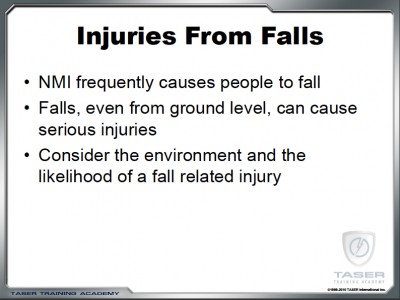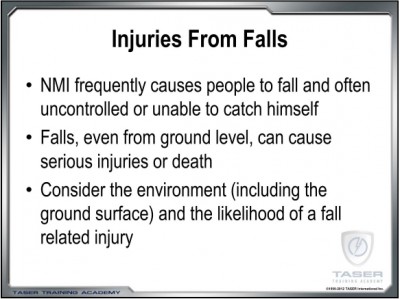The Case of Matthew Murphy / Another Cover-Up?
8:30 on a Saturday morning. It’s already hot and with no AC in the car it’s going to get a whole lot hotter by the time we get into Miami.
At her mother’s tiny apartment on Olivia Street, Mary Annuylsse is getting 3-year old Kaeden Murphy ready to go see his dad, Matthew, at Jackson Memorial Hospital. As we reported in previous articles, Matthew Murphy has been stuck in a hospital bed ever since he was tased by a Key West police officer on April 16, 2011. We’d been told he was unable to walk, speak, or eat on his own, but that he could communicate by blinking his eyes. We are in for the ride.
Getting the rest of the family taken care of for a day is a juggling act for Marie. “Good thing you have friends to pick up the slack.” “Oh don’t worry,” says Marie, “I am going to pay for all those little favors for a week.” And we’re off.
A thousand miles away another juggling act has already played out: Matthew’s father Marty and his mother, Lynne, have been on the road since the previous day. They are driving down in the family car, all the way from a small coal-mining town in West Virginia.
We are all going to meet at the hospital with personal injury attorney Charlie Flynn. Matthew is in Jackson Memorial’s Longterm Care Center, a place patients rarely get to walk out of. Everyone is either stuck in a bed or in a wheelchair. The latter don’t seem to have the strength to move the wheels or have nowhere to go. The hardiest hit you for a quarter at the entrance to the cafeteria. Their immediate family is a group of Haitian nurses who joke around with every patient and blow life into the forsaken.
Matthew is, in some strange way, one of the lucky ones. He still has parents and a fiance looking after him, praying for his recovery. But at 30, he’s a young man who could outlive his aging parents. Many of these patients become castaways, forgotten at the end of a corridor, with no one even remembering they still exist.
Right now, Matthew is lying in a two-bed hospital room. He has just recovered from a bout of pneumonia that the nurses say was induced by the fact that he’s unable to move at all. The whole thing about communicating by blinking his eyes certainly isn’t working today. The hospital records say, “vegetative state.”
“He is the first thing on my mind in the morning and the last thing I think about when I go to bed,” says Marty Murphy. Marty would have retired by now, but he’s trying to save enough money to move Matthew closer to home. The transportation alone will cost $ 50,000. Around Matthew’s bed, a whirlwind of emotions passes among family members. We go outside to talk to the lawyer.
So is anyone liable for this tragedy?
Matthew Murphy got into a verbal argument with local fisherman Jason Moffet while coming back home from a night on the town with his fiancé. At about 3:30 am, the argument had drawn a crowd on the 300 block of Duval Street. Officer Siracuse, responding to a 911 call, tased Murphy allegedly without warning, after he saw him punch Moffet in the face. Murphy fell like a log, hit his head and lost consciousness. He’s been paralyzed ever since.
“It was just a fight,” Moffet told us recently, “no one should have lost their life. The dude ]Murphy] never knew the officer was there.”
After speaking with the attorney, it seems that three actors could be liable: Officer Siracuse, who allegedly fired the Taser without warning; Taser International, the company that sold the Tasers seemingly without adequate warning of the risks of tasing someone standing at ground level on a hard surface; and the City of Key West, which arguably has a Taser policy that is contrary to Florida Statute and a custom of deliberately white-washing instances of excessive force.
I. Officer Siracuse
Officer Siracuse gave two different versions of what happened that night. In his August 16, 2011 Incident Report he claimed that he came from the north facing Murphy, pulled his Taser out of its holster, activated it and pointed the light and the laser pointer at Murphy and then announced himself, “Key West Police.” He wrote in his report that Murphy “ignored the light and the laser” and punched Moffet, who recoiled and “immediately started bleeding.” When it appeared that Murphy was about to punch again, Officer Siracuse claimed he then fired his Taser and Murphy fell to the ground.
This report was later supplemented with a diagram showing the Taser probes had hit Murphy from the front, penetrating the right shoulder area and the front of his left leg. Three years ago, this version of the facts cleared the officer from any wrongdoing.
Under Florida Statute 943.1717, police officers may only fire a Taser after a person “escalates resistance to the officer from passive physical resistance to active physical resistance.” But Matthew’s fiancé challenges the notion that Murphy actively resisted.
“Matthew was not resisting,” says Marie Annuylsse, “how could he be resisting if we didn’t even know the officer was there? He came from behind and never said anything and all of a sudden Matthew was on the ground.”
But in his report Siracuse swore he clearly announced himself, pointed the light and Taser guiding system not far from Murphy’s face, and fired only after it became apparent that Murphy was going to strike Moffet a second time and was deliberately ignoring the officer.
FDLE was supposed to investigate but did not. Matthew Murphy, stuck in a hospital bed, seemed to have fallen into some legal crack until The Blue Paper unearthed his story. The State Attorney’s Office and the CRB have since begun investigating and Officer Siracuse is now telling quite a different story.
As it turns out the officer is facing an enemy he can’t oppose. That enemy is the Taser video – video captured that night by the officer’s own Taser.
The video clearly shows that the Taser was not fired from the north with the Officer facing Murphy as Siracuse initially reported, but rather from the east of Murphy and slightly to his back. Siracuse in a new sworn statement collected by the State Attorney’s Office a few weeks ago seems to concede that fact.
See the video below for a graphic illustration of events:
The video also shows that Officer Siracuse couldn’t have had the Taser’s light and the laser pointed at Murphy as a warning: If such was the case, the video would have recorded it. At the time Siracuse claimed the Taser was activated, the video would have also recorded Murphy punching Moffet, Moffet bleeding and crouching in pain, and Murphy ready to punch again. But none of that was recorded.  The only thing that was recorded is a black and white zombie-like video of a Taser fired immediately after being activated. The Taser’s electric wires dance for a split second in front of the camera, Murphy collapses on the floor seized in an expression of pain and terror.
The only thing that was recorded is a black and white zombie-like video of a Taser fired immediately after being activated. The Taser’s electric wires dance for a split second in front of the camera, Murphy collapses on the floor seized in an expression of pain and terror.
“The original police report was a total fabrication,” says Marie Annuylsse, “and everyone went along with it because no one bothered to look carefully at the video and because that is what they wanted to believe.”
There is another controversial element to the police report. It concerns what should be in the report but is missing. Where are the photos of the probe entrance wounds?
Under strict KWPD policy 03.29.02.06 Post Deployment Procedures
“I. If the probes have penetrated the skin, the puncture sites shall be brought to the attention of a supervisor and photographed, along with the air cartridge, probe wires, and probes.”
Would photos have shown that the probes actually hit Matthew on the side and in the back, instead of in the front, contradicting the Officer’s account? A complete list of witnesses and their contact information is also missing.
We are told that an officer is liable for excessive force if he knew or should have known that he violated a clearly established law. Was Matthew Murphy given his opportunity to stand down before being tased as is his right under the law. Would he have stopped fighting and avoided the horrific consequences of that Taser blast?
“I know Matthew,” says Marie, “he would not have kept fighting if he had known the officer was there. None of this would have ever happened.”
II. The City of Key West
The City can only be dragged into an excessive force case if a Plaintiff can show that a City policy or custom was at play.
The City must follow State Statute governing the use of a Taser. The statute requires that officers limit their use of Tasers to situations where there is “active resistance to the officer.”
But Key West Police Polciy 03.29.02.05 Guidelines for Use of an Electronic Control Weapon advises officers that they only need to give a warning “when practical.”
“D. Whenever practical, the warning “Taser” should be given prior to discharge of the Taser device.”
Did Officer Siracuse believe the City had released him from his duty to abide by the Florida Statute and had given him the discretion to find it “more practical” to shoot first and ask questions later?
The City is also liable if it is “deliberately indifferent” to it’s officers’ lack of proper training or abuse of force.
In this case, Chief Donie Lee, the City’s final policymaker in police matters, decided to exonerate the officer responsible for this horrific injury. The Chief did not care that the mandatory photos necessary for a proper investigation were not in the file or that multiple witnesses had not been listed with contact information for full inquiry. Instead, the Chief actually made up excuses for the officer, claiming repeatedly to the media that, “[The officers] were giving verbal commands for the people to separate and stop fighting. They refused to do so…” Nowhere on the officers’ reports does it say that Murphy and Moffet were “given verbal commands to separate and stop fighting.” With all due respect, it looks like the Chief just totally made that one up.
This is very similar to the cover-up pattern that has been observed in the Eimers case. A court could decide that the City has a custom of deliberately ignoring claims of excessive force.
III. Taser International
Taser International makes approximately $ 100 Million in profit a year manufacturing the Tasers that ruined Murphy’s life. The company could be liable if a Plaintiff could show that it failed to adequately warn its customers of the possible dangers associated with the use of their electronic control weapon.
Does Taser International adequately warn the public about the risk of falls like the one suffered by Murphy? By some strange twist of fate, on February 17, 2011, just two months prior to Murphy’s injury, Taser International issued a new warning:
Was that enough? Was it adequate to unequivocally warn Siracuse of the risk he was taking with Murphy’s health when he fired that Taser? Yes and No. It did warn of the risk of serious injury at ground level, but what is serious injury? A broken arm is a serious injury. And what type of “environment” could cause a serious fall related injury?
Obviously Taser International officials didn’t believe the warning was “adequate” because they corrected it nine months after Murphy’s injury with an amended version issued on January 18, 2012. This one added the risk of death associated with a fall at ground level and specified that the type of ground surface could be the factor causing the injury.
Now, that could be a warning that might bring a more cautious use of the Taser, but wouldn’t an adequate warning be something more like, “Don’t tase anyone standing on a hard surface unless the use of lethal force is both necessary and legally justifiable.” In other words don’t use a Taser if you would not be justified in using a gun.
That is the warning that could have saved Murphy. He was involved in a simple battery; a misdemeanor, which typically doesn’t qualify for the use of lethal force. Had Officer Siracuse been wrongfully left with the illusion that his Taser could not cause such irreversible injuries?
~~~~~~~~~~~~~~~~~~~~
To access all Blue Paper articles on the tasing of Matthew Shaun Murphy click here.





“FDLE was supposed to investigate but did not.” So, wonder who at FDLE dropped the ball on this one? Carol Fredericks? Captain Scott Smith’s ex-wife Kathy Smith? Who? Who could it be? Is there a way of finding out who received the report or request?
The person in charge at FDLE at the time was Vince Weiner. The SAO in its “investigation” [called “a whitewash” by CRB member Tom Milone – one might add to that that bleach was used…] claims none of the agency members who had signed the Memorandum of Understanding in 2003 knew that the document called for an investigation of not only a death-in-custody but also of a serious injury [until The Blue Paper pointed in out in a previous article]. Police Chief Donie Lee at the most recent CRB hearing announced that he has spoken with FDLE representatives about rewriting their agreement with an eye toward removing any requirment for an FDLE investigation in cases like the tasing of Matthew Murphy where a suspect is seriously injured during an arrest. FDLE was alerted that Matthew had been injured by KWPD, FDLE verified that Murphy was in critical condition on a ventillator at Jackson Memorial Hospital and then closed their file. There is no indicaton that they followed up to be sure he had not died thereafter. One wonders what FDLE would have done in the Eimers case had there not been any media atttention… he too was in a hospital bed in critical condition on a ventillator when they were alerted to his serious injury last Thanksgiving.
People are dying because of unchecked police violence and the police keep getting a pass. What happened to serve and protect? The vetting of potential police officers needs to be improved. Most police officers are good people, but the psychopaths need to be weeded out.
This awful case is a good opportunity for the CRB to start regaining the public’s respect in Key West. I hope Tom Milone leads that charge.
For me, the key issue in the case is: Did Officer Siracuse shoot Murphy in the back without warning?
Tasers a used by law enforcement all over America.
Maybe tasers should not be used by police
Instead of shooting people with tasers, police shoot people with pistols, shotguns and assault rifles.
I still don’t get why Murphy went after the racist woman’s boyfriend, who, according to earlier blue paper reporting, told Murphy she was drunk and tried to talk Murphy down, persuade him to shrug it off and move on,
“”Police Chief Donie Lee at the most recent CRB hearing announced that he has spoken with FDLE representatives about rewriting their agreement with an eye toward removing any requirment for an FDLE investigation in cases like the tasing of Matthew Murphy where a suspect is seriously injured during an arrest.””
Oh yeah… That sounds like a real good idea! Wonder if the City Manager and Commissioners will go for that?
The Charles Eimers case proved an FDLE examination is a joke. The same case hopefully will not prove the State Attorney is a joke. Time will tell. The City Manager, Mayor and City Commissioners have yet to express any indication they see there is a problem in their police department. No candidate forum asked the mayor candidates anything about KWPD. Arnaud Girard told me about two weeks ago now, that’s because their going after KWPD would be bad for business. That’s true. But it’s deeper than that. Or worse than that might be more apt. City Hall views its police as off limits. It’s been that way since I arrived here in late 2000. I hear it’s been that way much longer. Mayor Cates hasn’t addressed it, nor will he. Nor has, nor will, Margaret Romero. The CRB can address it, but has no power. The mayor is the best person to address it, because the mayor has the press and other news media reporting his words and actions. The mayor could make a huge stink, and keep making a huge stink, and it just might go viral. Would anything change? Who can say? It would change the atmosphere in Key Westm though. No longer would the KWPD be off limits in, hmmm, city commission meetings; newspaper and radio interviews, speeches before community organizations, CRB meetings attended by the mayor, who speaks during citizen comments, and when else is allowed or invited. The mayor could call the FBI, the US Department of Justice. The KWPD would be center stage in bright sunlight ongoing. Until, yeah, the mayor was shot and killed. Or just disappeared like Bum Farto.
Intelligence Quotient Exam + Medical Appraisal + Physical Fitness Evaluation + Police Psychological Assessment Test + Interview By A Licensed Psychologist or Psychiatrist + Graduation From Recruit Training—Is Required By Most Police Departments Before A Candidate Is Given Their Badge & Gun…
The following are some traits that ordinarily disqualify an individual from becoming a police officer:
1) Below average problem-solving and social judgment suggests a lack of experience in making decisions while under pressure, particularly when being pulled in several different directions by people or issues that might influence you. In short, it comes down to a lack of life experience.
2) Difficulty presenting information in a straight forward manner suggests you may have difficulty analyzing facts and relating them to others in a brief, concise and accurate manner. Instead, it suggests you may include too much information, unnecessarily injecting other factors that have no relevance and complicating resolution of the matter. Again, this suggests a lack of life experience.
3) Aggressive behavior – Prospect that displays an unwillingness to listen to authority or is in a constant state of aggression will raise a red flag to the examiner, and as a result will issue the department a “not suitable to be a police officer” recommendation.
Can this data be secured from the KWPD, as it relates to personnel involved with Mr. Murphy’s injuries and Mr. Eimers’ death?
Maybe that info can be obtained, but I think it begs the question, John. Perhaps if you lived in Key West, you will see this situation differently. Although I imagine most people living here don’t want to see it for what it is, given the Citizen does not break these awful cases. Given police problems are not asked of candidates at candidate forums. Given the way Police Chief Donnie Lee has responded to the Murphy case and the Eimers case. Given how the mayor and city commissioners have responded – silence. Given what I perceive as a lot of apathy, but perhaps I’m mistaken; I hope I am mistaken.
I found myself thinking off and on yesterday. in the way last years referendum produced a statement how 74 percent of Key West people feel about cruise ships, not good, the mayor’s race outcome this year will produce a statement how Key West people feel about their police department. If I don’t survive the August 26 mayoral primary, you will know how the people of Key West feel about their police department.
ironically, those three traits you listed are exactly what the police DO look for in their applicants.
that makes them more compliant, less apt to think, or care, about what they are really doing, and actually hiring people who enjoy that type of work.
ask CaptainLarry….
Mr. Donnelly, it appears those are common traits in all cops that I happen to know both in the MCSO and KWPD. They tend to have some sort of massive chip on their shoulders, and often have a lot of imagined slights in their lives, and are trying to ‘get even’ in every single contact they make.